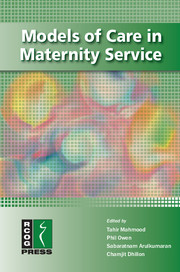Book contents
- Frontmatter
- Contents
- About the authors
- Abbreviations
- Preface
- CHAPTER 1 Setting the scene
- CHAPTER 2 Developing and implementing a local maternity services strategy: the clinical director's role
- CHAPTER 3 Prepregnancy services for women with social needs
- CHAPTER 4 Access to early pregnancy care
- CHAPTER 5 Antenatal fetal abnormality screening
- CHAPTER 6 Antenatal care for low-risk pregnancy
- CHAPTER 7 Antenatal care for women with pre-existing medical, obstetric or mental health conditions
- CHAPTER 8 Antenatal care for women developing medical or obstetric problems during pregnancy
- CHAPTER 9 Managing risk in antenatal care
- CHAPTER 10 Intrapartum care for women assessed as low risk in labour
- CHAPTER 11 Intrapartum care for high-risk pregnancies
- CHAPTER 12 Obesity in pregnancy
- CHAPTER 13 Prevention of hypoxic ischaemic encephalopathy
- CHAPTER 14 Risk management on the labour ward
- CHAPTER 15 Place of birth
- CHAPTER 16 High-risk pregnancy and neonatal services
- CHAPTER 17 Anaesthesia service provision for maternity services
- CHAPTER 18 Postnatal care
- CHAPTER 19 Supporting families who experience adverse outcomes during pregnancy
- CHAPTER 20 The maternity dashboard
- CHAPTER 21 Commissioning for regional maternity services: an example from the East of England
- CHAPTER 22 Key indicators
- Index
CHAPTER 1 - Setting the scene
Published online by Cambridge University Press: 05 July 2014
- Frontmatter
- Contents
- About the authors
- Abbreviations
- Preface
- CHAPTER 1 Setting the scene
- CHAPTER 2 Developing and implementing a local maternity services strategy: the clinical director's role
- CHAPTER 3 Prepregnancy services for women with social needs
- CHAPTER 4 Access to early pregnancy care
- CHAPTER 5 Antenatal fetal abnormality screening
- CHAPTER 6 Antenatal care for low-risk pregnancy
- CHAPTER 7 Antenatal care for women with pre-existing medical, obstetric or mental health conditions
- CHAPTER 8 Antenatal care for women developing medical or obstetric problems during pregnancy
- CHAPTER 9 Managing risk in antenatal care
- CHAPTER 10 Intrapartum care for women assessed as low risk in labour
- CHAPTER 11 Intrapartum care for high-risk pregnancies
- CHAPTER 12 Obesity in pregnancy
- CHAPTER 13 Prevention of hypoxic ischaemic encephalopathy
- CHAPTER 14 Risk management on the labour ward
- CHAPTER 15 Place of birth
- CHAPTER 16 High-risk pregnancy and neonatal services
- CHAPTER 17 Anaesthesia service provision for maternity services
- CHAPTER 18 Postnatal care
- CHAPTER 19 Supporting families who experience adverse outcomes during pregnancy
- CHAPTER 20 The maternity dashboard
- CHAPTER 21 Commissioning for regional maternity services: an example from the East of England
- CHAPTER 22 Key indicators
- Index
Summary
Introduction
Maternity services in the UK enjoy high-quality, safe service, yet there is room for improvement. The Healthcare Commission survey carried out 3 years ago highlighted that 89%of women are satisfied or are more than satisfied with the care provided. Maternal mortality in the UK is 13/100 000 and 50% of cases are from direct causes. Substandard care has been identified in a number of cases. The clinical spectrum of cases seen in current labour wards appears to be different from that seen 50 years ago and the same is true for the causes of maternal mortality and morbidity. Maternal mortality from cardiac disease 40 years ago was mainly attributable to rheumatic heart disease. In the late 1990s, death was due to congenital heart disease. In the first decade of the 21st century, increasing numbers of deaths are from acquired heart disease such as myocardial infarction. This change may be because of background factors such as obesity, increasing age, associated conditions such as hypertension and diabetes and an increasing number of immigrant women presenting with undiagnosed cardiomyopathies. The Confidential Enquiry into Maternal Deaths 2003-2005 indicated that nearly 33% of mothers who died were in the obese category. An additional dimension that has come to light is that more pregnancies are presenting with complex social factors; for example, more maternal deaths are seen in women whose children are in care. Psychiatric disease is one of the leading indirect causes of maternal death.
Keywords
- Type
- Chapter
- Information
- Models of Care in Maternity Services , pp. 1 - 9Publisher: Cambridge University PressPrint publication year: 2010
- 1
- Cited by



